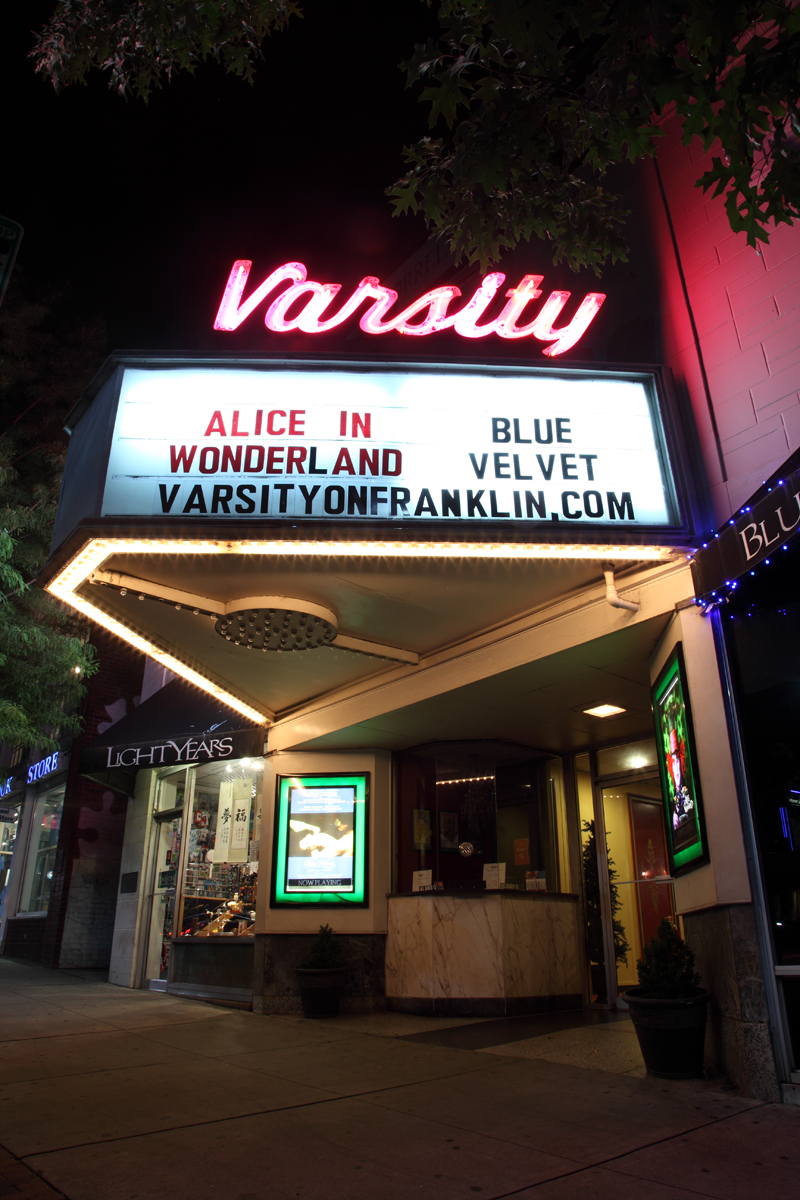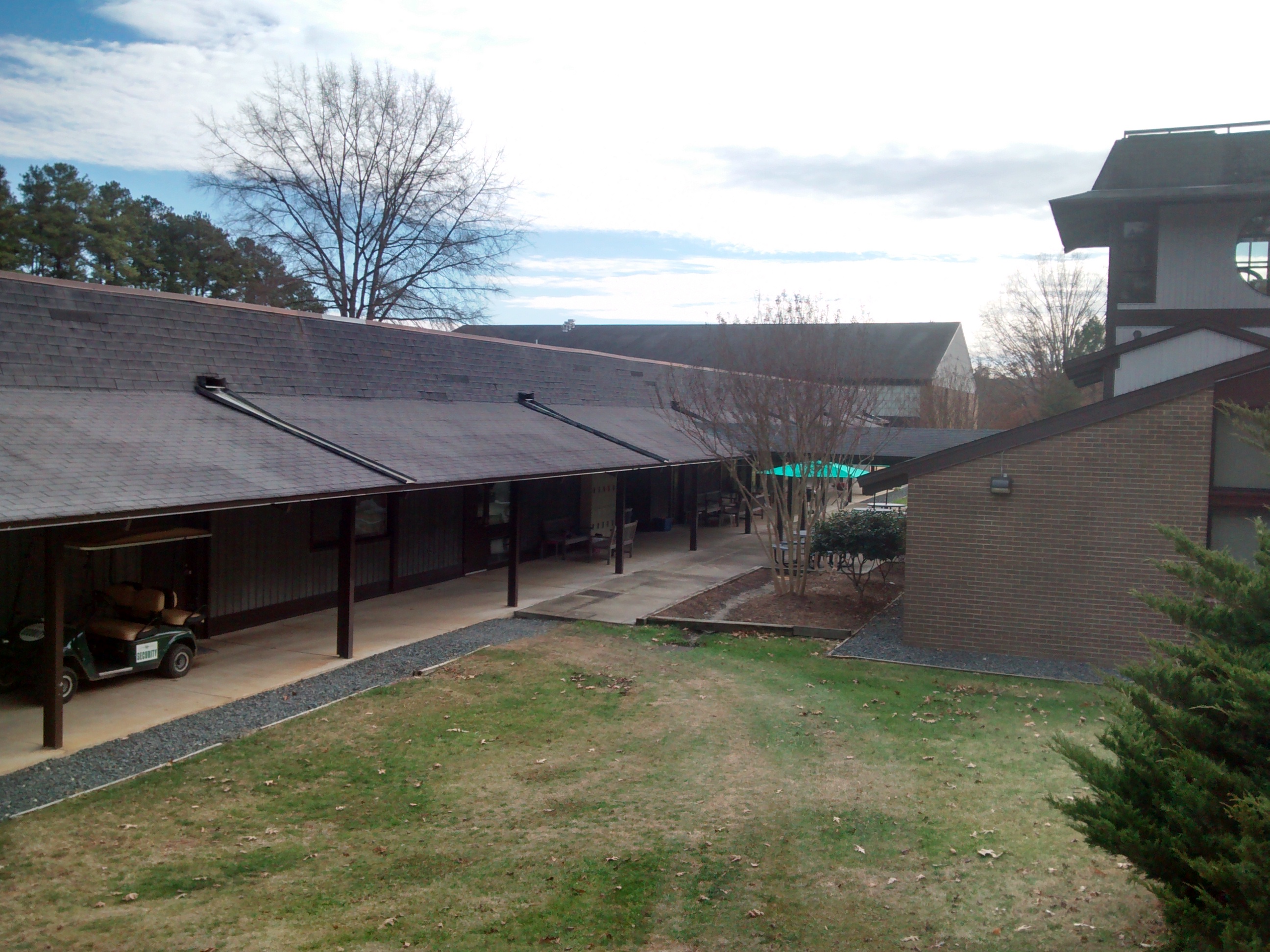|
Harwood Hall
Harwood Hall, also known as the George Watts House, was a mansion in the Morehead Hill Neighborhood of Durham, North Carolina. It was built for American manufacturer and philanthropist George Washington Watts in 1897. Following his death, Watts' second wife and widow, Sara Virginia Ecker Watts, stayed in the house until her remarriage to North Carolina Governor Cameron A. Morrison. The wedding ceremont of Sara Watts and Governor Morrison took place at Harwood Hall. After his widow's remarriage, the house passed down to Watts' daughter, Annie Louise Watts, and her husband, John Sprunt Hill. The house was later inherited by their son, the banker and philanthropist George Watts Hill. The mansion was demolished in 1961 to make way for what would become Duke University School of Medicine's Physician Assistant Program building. History In 1879, Baltimore businessman George Washington Watts decided to build a residence on the ridge of a small valley by West Chapel Hill Street in wh ... [...More Info...] [...Related Items...] OR: [Wikipedia] [Google] [Baidu] |
Châteauesque
Châteauesque (or Francis I style,Whiffen, Marcus, ''American Architecture Since 1780: A guide to the styles'', The MIT Press, Cambridge, MA, 1969, p. 142. or in Canada, the Château Style) is a Revivalist architectural style based on the French Renaissance architecture of the monumental châteaux of the Loire Valley from the late fifteenth century to the early seventeenth century. The term ''châteauesque'' (literally, " château-like") is credited (by historian Marcus Whiffen) to American architectural historian Bainbridge Bunting, although it can be found in publications that pre-date Bunting's birth. As of 2011, the Getty Research Institute's ''Art & Architecture Thesaurus'' includes both "Château Style" and "Châteauesque", with the former being the preferred term for North America. The style frequently features buildings heavily ornamented by the elaborate towers, spires, and steeply-pitched roofs of sixteenth century châteaux, themselves influenced by late Go ... [...More Info...] [...Related Items...] OR: [Wikipedia] [Google] [Baidu] |
Watts Hospital
Watts Hospital, located in Durham, North Carolina was the city's first hospital, operating between 1895 and 1976. The hospital opened in 1895, funded entirely by George W. Watts, as a private, 22-bed, modern hospital dedicated to the care of Durham's white citizens and offered free care to those unable to pay. The hospital became public in 1953 and closed 1976, when Durham County General Hospital opened. The grounds and buildings of the hospital's 1909 campus were converted to become the North Carolina School of Science and Mathematics, which began classes in 1980. History Watts was established in 1895, on land donated by George Watts with an endowment of $50,000, provided solely by Watts. The land fronted on West Main Street with Guess Road (later renamed Buchanan Blvd.) to the west and Watts Street to the east. By 1909, the 22-bed hospital was insufficient for the explosive growth of Durham, and new, larger facility was built on at the intersection of Club Boulevard and Br ... [...More Info...] [...Related Items...] OR: [Wikipedia] [Google] [Baidu] |
Duke University Campus
Duke is a male title either of a monarch ruling over a duchy, or of a member of royalty, or nobility. As rulers, dukes are ranked below emperors, kings, grand princes, grand dukes, and sovereign princes. As royalty or nobility, they are ranked below princess nobility and grand dukes. The title comes from French ''duc'', itself from the Latin '' dux'', 'leader', a term used in republican Rome to refer to a military commander without an official rank (particularly one of Germanic or Celtic origin), and later coming to mean the leading military commander of a province. In most countries, the word ''duchess'' is the female equivalent. Following the reforms of the emperor Diocletian (which separated the civilian and military administrations of the Roman provinces), a ''dux'' became the military commander in each province. The title ''dux'', Hellenised to ''doux'', survived in the Eastern Roman Empire where it continued in several contexts, signifying a rank equivalent to a capt ... [...More Info...] [...Related Items...] OR: [Wikipedia] [Google] [Baidu] |
Demolished Buildings And Structures In North Carolina
Demolition (also known as razing, cartage, and wrecking) is the science and engineering in safely and efficiently tearing down of buildings and other artificial structures. Demolition contrasts with deconstruction, which involves taking a building apart while carefully preserving valuable elements for reuse purposes. For small buildings, such as houses, that are only two or three stories high, demolition is a rather simple process. The building is pulled down either manually or mechanically using large hydraulic equipment: elevated work platforms, cranes, excavators or bulldozers. Larger buildings may require the use of a wrecking ball, a heavy weight on a cable that is swung by a crane into the side of the buildings. Wrecking balls are especially effective against masonry, but are less easily controlled and often less efficient than other methods. Newer methods may use rotational hydraulic shears and silenced rock-breakers attached to excavators to cut or break through wo ... [...More Info...] [...Related Items...] OR: [Wikipedia] [Google] [Baidu] |
Châteauesque Architecture In The United States
Châteauesque (or Francis I style,Whiffen, Marcus, ''American Architecture Since 1780: A guide to the styles'', The MIT Press, Cambridge, MA, 1969, p. 142. or in Canada, the Château Style) is a Revivalist architectural style based on the French Renaissance architecture of the monumental châteaux of the Loire Valley from the late fifteenth century to the early seventeenth century. The term ''châteauesque'' (literally, "château-like") is credited (by historian Marcus Whiffen) to American architectural historian Bainbridge Bunting, although it can be found in publications that pre-date Bunting's birth. As of 2011, the Getty Research Institute's ''Art & Architecture Thesaurus'' includes both "Château Style" and "Châteauesque", with the former being the preferred term for North America. The style frequently features buildings heavily ornamented by the elaborate towers, spires, and steeply-pitched roofs of sixteenth century châteaux, themselves influenced by late Gothic ... [...More Info...] [...Related Items...] OR: [Wikipedia] [Google] [Baidu] |
Buildings And Structures Demolished In 1961
A building, or edifice, is an enclosed structure with a roof and walls standing more or less permanently in one place, such as a house or factory (although there's also portable buildings). Buildings come in a variety of sizes, shapes, and functions, and have been adapted throughout history for a wide number of factors, from building materials available, to weather conditions, land prices, ground conditions, specific uses, prestige, and aesthetic reasons. To better understand the term ''building'' compare the list of nonbuilding structures. Buildings serve several societal needs – primarily as shelter from weather, security, living space, privacy, to store belongings, and to comfortably live and work. A building as a shelter represents a physical division of the human habitat (a place of comfort and safety) and the ''outside'' (a place that at times may be harsh and harmful). Ever since the first cave paintings, buildings have also become objects or canvasses of much artisti ... [...More Info...] [...Related Items...] OR: [Wikipedia] [Google] [Baidu] |
Chapel Hill, North Carolina
Chapel Hill is a town in Orange County, North Carolina, Orange, Durham County, North Carolina, Durham and Chatham County, North Carolina, Chatham counties in the U.S. state of North Carolina. Its population was 61,960 in the 2020 United States Census, 2020 census, making Chapel Hill the List of municipalities in North Carolina, 17th-largest municipality in the state. Chapel Hill, Durham, North Carolina, Durham, and the state capital, Raleigh, North Carolina, Raleigh, make up the corners of the Research Triangle (officially the Raleigh–Durham–Cary combined statistical area), with a total population of 1,998,808. The town was founded in 1793 and is centered on Franklin Street (Chapel Hill), Franklin Street, covering . It contains several districts and buildings listed on the National Register of Historic Places. The University of North Carolina at Chapel Hill and UNC Health Care are a major part of the economy and town influence. Local artists have created Murals of Chapel Hill, ... [...More Info...] [...Related Items...] OR: [Wikipedia] [Google] [Baidu] |
Franklin Street (Chapel Hill)
Franklin Street is a prominent thoroughfare in Chapel Hill, North Carolina. Historic Franklin Street is considered the center of social life for the University of North Carolina at Chapel Hill, as well as the town of Chapel Hill. It is home to numerous coffee shops, restaurants, museums, bookshops, music stores and bars. The street in downtown Chapel Hill is notable for its nightlife, culture, and regular festivities. The stretch of college-oriented businesses continues west into neighboring Carrboro, where the street's name changes to Main Street. Both streets are home to small music venues, like the Cat's Cradle and the Carrboro Arts Center, which were influential in the birth of Chapel Hill rock. UNC's Morehead Planetarium and Science Center, as well as the Ackland Art Museum are also located in this area. Geography The three-mile (5 km) length is divided into West and East Franklin Streets. West Franklin begins at the intersection of South Merrit Mill Road where Carrb ... [...More Info...] [...Related Items...] OR: [Wikipedia] [Google] [Baidu] |
North Carolina Symphony
The North Carolina Symphony (NCS) is an American orchestra based in Raleigh, North Carolina, with sixty-six full-time musicians. The orchestra performs in Meymandi Concert Hall and performs occasionally with the Carolina Ballet and the Opera Company of North Carolina. In 2017–18, the organization celebrated its 85th anniversary season. Concert series are also performed across North Carolina in the cities of, Chapel Hill, Cary, Southern Pines, New Bern, Wilmington, and Fayetteville, among others. History In 1932, Lamar Stringfield united a group of volunteers to form the North Carolina Symphony. They first performed in Hill Hall at the University of North Carolina Chapel Hill in North Carolina on May 14, 1932. The original musicians of the symphony were unpaid local musicians. By 1935, the North Carolina Symphony had performed in more than fifty cities and towns in North Carolina, in over 140 concerts. Dr. Benjamin Swalin, Music Director from 1939 to 1972, continued the ... [...More Info...] [...Related Items...] OR: [Wikipedia] [Google] [Baidu] |
World War II
World War II or the Second World War, often abbreviated as WWII or WW2, was a world war that lasted from 1939 to 1945. It involved the World War II by country, vast majority of the world's countries—including all of the great powers—forming two opposing military alliances: the Allies of World War II, Allies and the Axis powers. World War II was a total war that directly involved more than 100 million Military personnel, personnel from more than 30 countries. The major participants in the war threw their entire economic, industrial, and scientific capabilities behind the war effort, blurring the distinction between civilian and military resources. Air warfare of World War II, Aircraft played a major role in the conflict, enabling the strategic bombing of population centres and deploying the Atomic bombings of Hiroshima and Nagasaki, only two nuclear weapons ever used in war. World War II was by far the List of wars by death toll, deadliest conflict in hu ... [...More Info...] [...Related Items...] OR: [Wikipedia] [Google] [Baidu] |
John Sprunt Hill House
The John Sprunt Hill House is a historic house at 900 S. Duke street in Durham, North Carolina, in the Morehead Hill Historic District. Built in 1911–1912, it was the home of John Sprunt Hill (1869–1961) and his wife Annie Watts Hill (died 1940), daughter of George Washington Watts, co-founder of the American Tobacco Company. It was listed on the National Register of Historic Places The National Register of Historic Places (NRHP) is the United States federal government's official list of districts, sites, buildings, structures and objects deemed worthy of preservation for their historical significance or "great artistic v ... in 1978. Hill bequeathed the Spanish Colonial Revival mansion to a foundation created in memory of his wife. The Annie Watts Hill Foundation was created to support non-sectarian, non-political female organizations. As of 2008, the Junior League of Durham and Orange Counties makes its home here, although it is open to any group meeting the aforem ... [...More Info...] [...Related Items...] OR: [Wikipedia] [Google] [Baidu] |
Durham Academy, North Carolina
Durham Academy is an independent, coeducational, day school in Durham, North Carolina, whose 1,237 students range from pre-kindergarten to grade 12. The school has four divisions, each with its own director: Preschool (Pre-kindergarten/Kindergarten), Lower School (grades 1–4), Middle School (grades 5–8) and Upper School (grades 9–12). These are arrayed on three campuses that comprise four acres. Thirty-eight percent of Durham Academy's students are people of color, as are 17 percent of teachers. In 2019–20, Durham Academy awarded more than $2,200,000 in financial aid (not including tuition remission and need-based financial aid for faculty and staff); the average award was $14,682. History Durham Academy was founded in 1933, as the Calvert Method School, by George Watts Hill and his wife. The couple established the school as a private, independent school to educate their children. The school's teaching philosophy (and its name) were based on the Calver ... [...More Info...] [...Related Items...] OR: [Wikipedia] [Google] [Baidu] |







